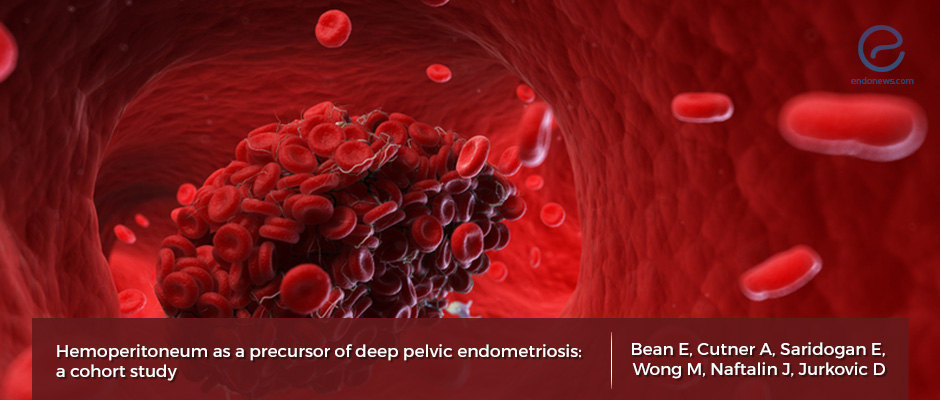The association of significant hemoperitoneum (blood in the abdominal cavity) and deep pelvic endometriosis
Jun 11, 2019
Some women with significant hemoperitoneum may develop deep endometriosis.
Key Points
Highlights:
- Significant hemoperitoneum (blood in the peritoneal cavity) that is managed conservatively in women with functional hemorrhagic cysts precedes the development of deep endometriosis.
Importance:
- The findings in this study could help the detection of women who are at risk of developing deep endometriosis.
Objective:
- Authors aimed to determine whether significant hemoperitoneum could be a precursor of deep pelvic endometriosis.
What's done here:
- 118 non-pregnant pre-menopausal women age ≥16 years who presented with severe acute lower abdominal pain assessed clinically and underwent detailed TVU scans; women with a previous or with a current diagnosis of endometriosis were excluded.
- Women were triaged for surgical or conservative management depending on the cause of pain and severity of their symptoms.
- Researchers invited all women with significant hemoperitoneum and those without evidence of significant hemoperitoneum to follow up visits to search for a newly developed endometriosis.
Key Results:
- The authors stated that they demonstrated the development of endometriosis in a previously normal pelvis for the first time.
- Hemorrhagic cysts in the presence of hemoperitoneum may precede the development of deep endometriosis.
- They observed blood clots in the pelvis before the development of endometriotic nodules. This provides a rational explanation for typical distortion of pelvic anatomy in women with deep endometriosis.
- Researchers' hypothesis is that peritoneal healing occurs over a blood clot and endometrial cells may be trapped under the peritoneal surface. The cyclical proliferation of endometrial cells after clot contracture and remodeling may result in the development of endometrial deposits on or under the peritoneal surface of the pelvis.
Limitations:
- This study is not able to explain the reasons why some women are more susceptible since the number of women who developed endometriosis is small.
- The rate of endometriosis in those not undergoing a follow-up ultrasound is unknown and may be different from those that did attend.
- Since authors were unable to identify women with occult peritoneal endometriosis by TVU at initial assessment, they cannot evaluate its effect in this study, which is extremely important.
Lay Summary
Although there are several theories to explain the etiology of deep endometriosis, the cause is unknown and there are currently no effective strategies to prevent its development.
Bean E. et al., from University College London Hospital, UK, observed that some women in their gynecology clinic who were referred with symptoms of chronic pelvic pain following conservative management of hemoperitoneum developed deep endometriosis.
Based on this observation, the authors conducted a prospective observational cohort study to test their hypothesis that the presence of significant hemoperitoneum (blood in the peritoneal cavity) that is managed conservatively may precede the development of deep pelvic endometriosis in some women. This study was published in the journal "Ultrasound in Obstetrics & Gynecology".
The study included 118 pre-menopausal, non-pregnant women who attended with severe acute lower abdominal pain and underwent a pelvic ultrasound examination. Patient demographics, past gynecological and obstetric history, previous history of endometriosis, past medical, surgical history and all relevant ultrasound findings including the presence of clinically significant hemoperitoneum and ultrasound features of endometriosis were recorded. Researchers invited the participants to follow up visits.
Seventeen percent of 118 women had emergency surgery and more than 80% were managed conservatively. Seventeen were excluded from the study due to current or pre-existing endometriosis. In the remaining 81 women, eight (10%) had evidence of clinically significant hemoperitoneum on pelvic ultrasound examination. A total of 35 women attended for all their follow up visits. Fourteen percent (5/35) were found to develop deep endometriosis. Four of these five women who developed deep endometriosis were initially presented with significant intra-abdominal bleeding while only one out of 29 (3%) did not have hemoperitoneum at the initial presentation. In 2 women who did not develop deep endometriosis, the pelvic blood clot had completely resolved within 43 and 58 days respectively.
Researchers observed that in some women blood clots do not clear, and later become more organized, dense and smaller due to contraction and the surrounding peritoneal adherence. Finally, solid incompressible hypoechoic lesions are formed, which have typical appearances of endometriotic nodules. This pattern suggested that blood clots in the pelvis may be precursors for the development of endometriotic nodules. They hypothesized that endometrial cells may be trapped under the peritoneal surface during the peritoneal healing over a blood clot. Clot contracture and remodeling followed by cyclical proliferation of endometrial cells may give rise to the development of endometrial deposits on or under the peritoneal surface of the pelvis.
According to the authors, this finding may be an explanation of the frequent presence of endometriotic nodules found in related areas as a result of natural deposition of clots due to gravitational pull. They also explain the distortion of normal anatomy and obliteration of the pouch of Douglas in women with deep endometriosis by their observation.
In conclusion, hemorrhagic cysts in the presence of hemoperitoneum can precede the development of deep endometriosis. The findings of this study could facilitate detection of women who are at risk of developing deep endometriosis. But, the small number of participants limits the study and we need further larger prospective studies to confirm the findings before targeted preventative strategies such as ovulation prevention or surgical evacuation of significant hemoperitoneum could be planned.
Research Source: https://www.ncbi.nlm.nih.gov/pubmed/30677178
deep endometriosis ultrasound pelvic pain hemoperitoneum abdominal cavity peritoneal cavity blood clot

